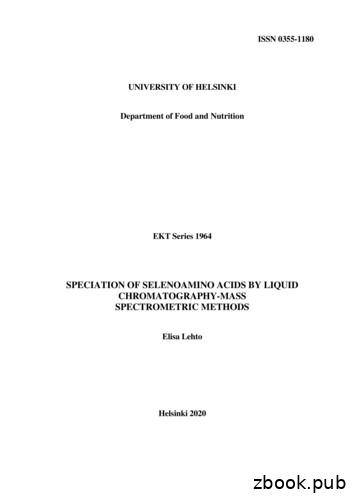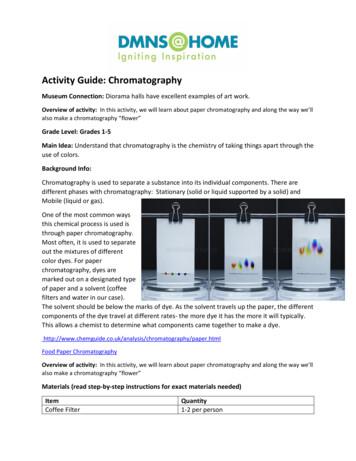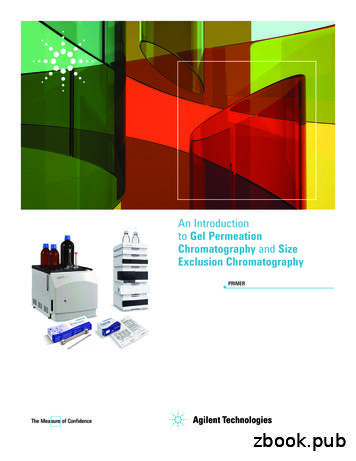Chromatography Page 1 8 Lab #5 SIZE EXCLUSION
Lab #5Chromatography Page 1 of 8SIZE EXCLUSION CHROMATOGRAPHYAdapted from: C. Greene MJCINTRODUCTION:Our bodies contain thousands of different proteins which perform many different jobs. Digestiveenzymes are proteins; some of the hormones signals that run through our bodies and theantibodies protecting us from disease are proteins. The information for assembling a protein iscarried (in code) in the DNA of our genes. The sections of DNA which contain the code for makingproteins are called genes. There are thousands of genes on each chromosome. Each gene codesfor a unique protein. The gene which makes a digestive enzyme in your mouth is different fromone which makes an antibody. Proteins vary greatly in size, and this principle can be used toseparate certain proteins from others of differing size.Proteins are often products sought to be used for medical purposes. Some of these proteins arepurified in large quantities from a naturally-occurring source. Recently, many proteins formedical purposes have been made through genetic engineering and recombinant DNAtechnology. No matter what the source, a protein of interest is found in a mixture of a cell'sother proteins. Some cells, such as bacteria, produce large quantities of up to two thousanddifferent kinds of proteins.Since 75% of the dry matter in living things is protein, biologists must often purify a protein ofinterest from other proteins in a cell. Determining the procedure for the purification of aparticular protein is a challenging task for the biotechnology industry. To separate any of themacromolecules, scientists utilize their knowledge of the chemistry of these molecules, including;the molecular weight of the protein (size), its charge, and its shape.Chromatography is commonly used in biotechnology for purifying biological molecules, likeproteins, for medicine or other uses. Chromatography separates individual components fromcomplex mixtures. Chromatography consists of a mobile phase (solvent and the molecules to beseparated) and a stationary phase either, in paper or glass beads, called resin, (in columnchromatography), through which the mobile phase (sample) travels.Molecules travel through the stationary phase at different rates because of their chemistry.In size exclusion chromatography (SEC), microscopic beads which contain tiny holes are packedinto a column. When a mixture of molecules is dissolved in a liquid and then poured onto a sizechromatography column that contains porous beads, large molecules pass quickly around thebeads, whereas smaller molecules enter the tiny holes in the beads and pass though the columnat a significantly reduced rate. Depending on the molecules, proteins many be separated basedon their size and fractions containing the isolated proteins can be collectedThe mass of beads within the column is often referred to as the column bed. The beads act as"traps" or "sieves" and function to filter small molecules which become temporarily trappedwithin the pores. Larger molecules pass around, or are "excluded" from, the beads. The columnyou will be using is prefilled with beads that effectively separate or "fractionate" molecules that
Chromatography Page 2 of 8are below 60,000 daltons. As the liquid flows through the column, molecules below 60,000daltons enter the beads and pass though the column more slowly. The smaller the molecules, theslower they move through the column. Molecules greater than 60,000 pass around the beadsand are excluded from the column quickly - also referred to as the exclusion limit of a column.Different columns have different exclusion limits.The liquid used to dissolve the biomolecules to make the mobile phase is usually called a buffer.The mixture of biomolecules dissolved in the buffer is called the sample. The sample is placed onthe column bed and the biomolecules within the buffer enter the top of the column bed, filterthrough and around the beads, and ultimately pass through a small opening at the bottom of thecolumn. For this process to be completed additional buffer is placed on the column bed after thesample has entered the bed. Then mobile phase liquid is collected, as drops, into collection tubeswhich are sequentially ordered. A set number of drops is usually collected into each tube. Thelarger molecules which pass quickly through the column will end up in the early tubes or"fractions". Then smaller molecules which penetrate the pores of the stationary phase end up inthe later fractions.Hemoglobin and vitamin B12 are the two molecules which are being separated in the lab activity.Hemoglobin, which is reddish/brown, has a molecular weight of 65,000 daltons and is thusexcluded from the column resin beads. Hemoglobin will pass more quickly through the columnand appear in the early collection tubes, or fractions. Vitamin B 12, which is pink, has a molecularweight of 1,350 daltons and is thus fractionated (slowed down) by the column. The vitamin B 12molecules penetrate the pores of the beads, becoming temporarily trapped. As a result, theypass much more slowly through the column and should appear in the later fractions.1. SIZE EXCLUSION CHROMATOGRAPHY SEPARATION:Objectives: Demonstrate an understanding of the principles and operations of size exclusionchromatography Separate biological molecules from blood serum using size exclusion chromatographyMaterials:12 collection tubes1 Size exclusion chromatography column1 Column end capDisposable pipette / P-1000Test tube rackPROCEDURE:Follow the Laboratory Quick Guide for Size Exclusion Chromatography on the next two pages.Apply the solution provided by your instructor.
Chromatography Page 3 of 8
Chromatography Page 4 of 8
Chromatography Page 5 of 8SAMPLE COLLECTION TUBES:Tube 1) Pre-collectionTubes 2-10) 5 drops from column in each tube2. DETERMINATION OF THE ABSORPTION SPECTRUM OF VITAMIN B12:An absorbance spectrum (a plot of absorbance as a function of wavelength) is determined toselect the optimal wavelength for analyzing a given compound. The optimal wavelength (Amax}for measuring absorbance is that wavelength that is most absorbed by the compound inquestion. This provides maximum sensitivity for your measurements.An absorption spectrum is a visual representation of how well a particular photochemicalabsorbs different wavelengths of light. Absorption spectrums are useful pieces of informationand can be employed in a number of ways in a research lab. Once the peak absorption(wavelength in which the photochemical absorbs or transmits the most amount of light) isdetermined, a spectrophotometer set at that wavelength can be used to quantify the amount ofthat substance in solution. The amount of light absorbed is directly proportional to the amountof substance in solution; the greater the amount of substance in solution, the greater amount oflight absorbed and visa versa. By comparing the amount of light absorbed of an unknownamount of substance to that of a known quantity of the same substance, through the use of astandard curve, the quantity of the substance can be roughly determined. Since the technique isquick and does not require costly reagents, it is feasible to consider using spectrophotometry asa quantification technique. In this case, we are using absorbance to differentiate between tubesthat contain vitamin B12 and those that do not.Of course, the usefulness of the technique hinges on the fact that the substance being testeddoes in fact absorb light. Vitamin B 12 is considered to be a photochemical and should lend itselfto being quantified using this technique.DETERMINATION OF THE ABSORPTION SPECTRUM OF VITAMIN B12:MATERIALS:Vitamin B12 solution (5.625 µM or 562.5nM)CuvettesP-1000 Micropipettor and blue tipsSpectrophotometerObjectives:1. Determine the Absorption Spectrum for Vitamin B122. Identify chromatography samples containing Vitamin B12 and those that do not
Chromatography Page 6 of 8PROCEDURE:Follow the same general process that you utilized in the spectrophotometry lab.SPECTROPHOTOMETER OPERATION:1. Press in the power button (located on the back of the instrument} to the ON position.2. Let the machine warm up for 10 min before you use it3. Enter the desired wavelength [380nm]4. Wipe off your cuvette containing the blank solution [column buffer] with a Kim Wipe andplace it in the single cuvette holder.Make sure that the cuvette is aligned with the light source. Be sure to have theclear faces of the cuvette facing towards the front of the machine!5. Close the sample compartment door.6. Press the AUTO ZERO button on the keypad. The display shows "ZEROING . " This shouldresult in 0% Absorption.7. Remove the blank.8. Insert the Vitamin B12 Sample (provided) into the sample compartment and close thesample compartment door.9. Read the absorbance displayed and record it10. Remove the cuvette, but save the cuvette and its contents.11. Adjust the Spectrophotometer to 390nm and repeat steps 8 – 10, ranging fromwavelengths 380nm to 680nm.12. Record your results on your worksheet.3. SPECTROPHOTOMETRIC DETECTION OF VITAMIN B12:An absorbance spectrum (a plot of absorbance as a function of wavelength) is determined toselect the optimal wavelength for analyzing a given compound. The optimal wavelength (Amax}for measuring absorbance is that wavelength that is most absorbMATERIALS:Tubes collected from Size Exclusion Chromatography separationCuvettesP-1000 Micropipettor and blue tipsSpectrophotometerObjectives:1. Use the Absorption Spectrum for Vitamin B12 to identify chromatography samplescontaining Vitamin B122. Demonstrate the separation of Vitamin B12 and Hemoglobin from blood serum
Chromatography Page 7 of 8PROCEDURE:Follow the same general process that you utilized in the spectrophotometry lab.SPECTROPHOTOMETRIC DETECTION OF VITAMIN B12:1. Use the spectrophotometer to detect the presence of vitamin B12 in yourchromatography samples.NOTE: You may need to increase the volumes of your samples to read them in thespectrophotometer – check with your instructor. What solution should you use to dothis?NOTE: You will set the spectrophotometer for the Amax you determined for vitamin B12in part 2 of this exercise.NOTE: You should use column buffer to blank the spectrophotometer to 0% Absorption.
Chromatography Page 8 of 8NO CONTENT
chromatography Separate biological molecules from blood serum using size exclusion chromatography Materials: 12 collection tubes 1 Size exclusion chromatography column 1 Column end cap Disposable pipette / P-1000 Test tube rack PROCEDURE: Follow the Laboratory Quick Guide for Size Exclusi
2.3.1 Liquid chromatography (LC) 20 Size-exclusion chromatography (SEC) 20 Ion-exchange chromatography (IEC) 22 Reversed-phase chromatography (RP) 23 Reversed-phase ion pairing chromatography (RPIP) 24 2.3.2 Gas chromatography (GC) 25 2.3.3 Electrophoretic techniques 25 2.3.4 Isotope dilution analysis (IDA) 26 3 EXPERIMENTAL RESEARCH 27 Aims 27
Chromatography 481 27.4.2 Partition (Liquid–Liquid) Chromatography 482 27.4.2.1 Introduction 482 27.4.2.2 Coated Supports 483 27.4.2.3 Bonded Supports 483 27.4.3 Ion-Exchange Chromatography 483 27.4.4 Size-Exclusion Chromatography 485 27.4.5 Affinity Chromatography 488 27.5 Analys
“Laboratory Chromatography Guide” – A close look at preparative liquid chromatography The present “Laboratory Chromatography Guide” is dedicated to preparative liquid chromatography, a common purification techni-que in most chemical or life science laboratories. T
1. A LC technique which separates solutes based on their adsorption to an un-derivatized solid particles is known as adsorption chromatography, or liquid-solid chromatography. 2. Adsorption chromatography was the first type of column liquid chromatography developed (Tsweet, 1903). However, it is currently
Affinity chromatography, (g) Gas chromatography, (h) Supercritical fluid chromatography, (i) High Performance Liquid Chromatography, (j) Capillary electrophoresis, 4. Classification of chromatographic methods - according to separation methods, according to development procedures. (i)Thin Layer Chromatography: Theory and principles, outline of the
Activity Guide: Chromatography Museum Connection: Diorama halls have excellent examples of art work. Overview of activity: In this activity, we will learn about paper chromatography and along the way we'll also make a chromatography "flower" Grade Level: Grades 1-5 Main Idea: Understand that chromatography is the chemistry of taking things apart through the
There are many forms of chromatography, but two are very common and well known to all analytical scientists and serve to illustrate the diversity of analytical techniques. These are gas chromatography (GC) and liquid chromatography (LC). GPC/SEC is a form of LC. These techniques are described in brief below. Gas chromatography
Gel filtration chromatography-An Overview Larger particles come out first, while smaller particles come in later fractions Biochemistry of Medics 33. 5) Affinity chromatography . High performance liquid chromatography-Significance Biochemistry of Medics 39. High performance liquid chromatography- Apparatus Biochemistry of Medics 40.























